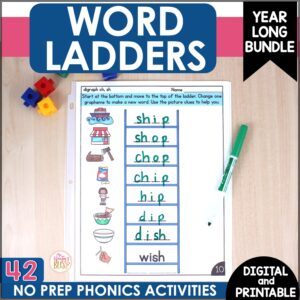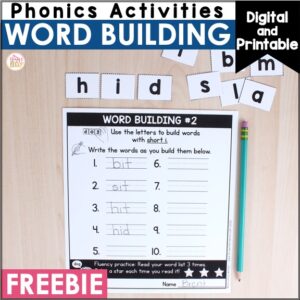Word building is a critical phonics activity. Students will develop word awareness skills as they explore and play with letter sounds to build words. Make sure to download the letter building cards and word building activities in this post.
One thing I love about teaching is that there is always the opportunity to learn, grow and become better. This past year I have spent a lot of time reading the work of Wiley Blevins. I’ve learned so much about phonics instruction and come to realize that there are aspects of the way I taught phonics that I would now change and improve.
One of my main takeaways from Blevins’ book, A Fresh Look at Phonics, is the importance of providing students with lots of opportunities for review and repetition in order to ensure they actually master the skills that we teach!
I realized that in my own teaching (and I confess!) I was guilty of exposing my students to a phonics skill, taking them through my weekly word study routine, and then moving onto the next skill the following week. I’m afraid I wasn’t giving them enough practice to ensure mastery.

Even if you know you need to provide this extra practice, it can be a challenge to come up with activities that effectively meet your needs. In his book Phonics from A to Z, Wiley Blevins suggests using word sorts and word building activities as a way to allow students to explore and play with letter sounds.
In my last blog post I shared all about word sorts, so today I’m excited to provide you with information about word building activities and share some resources to help get you started with these critical routines.
What are Word Building Activities?
In word building, students are given a set of letter cards and asked to create a series of words in a specified sequence. Usually, each new word varies by only one sound-spelling from the previous word. For example, students may build the following words in sequence: sat, hat, hop, mop. Each new word varies from the one before it by only one sound-spelling.

There are two types of word building activities, each with their own instructional purpose.
- Word Building: Blending Focus In this type of word building students are asked to make a word, such as cat. Then they would be asked to change the letter c to s and read the new word formed. The goal here is for them to blend, or sound out the new word. You can include many words with the new target phonics skill and also include previously taught skills.
- Word Building: Word Awareness Focus Here, students are asked to make a word such as cat, and then told to change it to hat. This requires a lot more thinking than blending-focused work. Students have to think about how the two words are different and which sound must be changed in order to form the new one.
Both of these word-building activities can be done with the same set of words, so incorporating both into your week gives your students good practice and saves you planning time!
Word Building Routines
The routine for word building is simple! First, introduce the task by naming it and explaining the purpose.
Next, MODEL! Place letter cards in a pocket cart to form the first word you are building. Model sounding out the word. As you build new words, be sure to include the new target sound-spelling as well as words with review sound-spellings. Use minimal contrasts to ensure students fully analyze the words and notice their unique differences. For example, sat/hat, mop/map, mad/made, cot/coat.
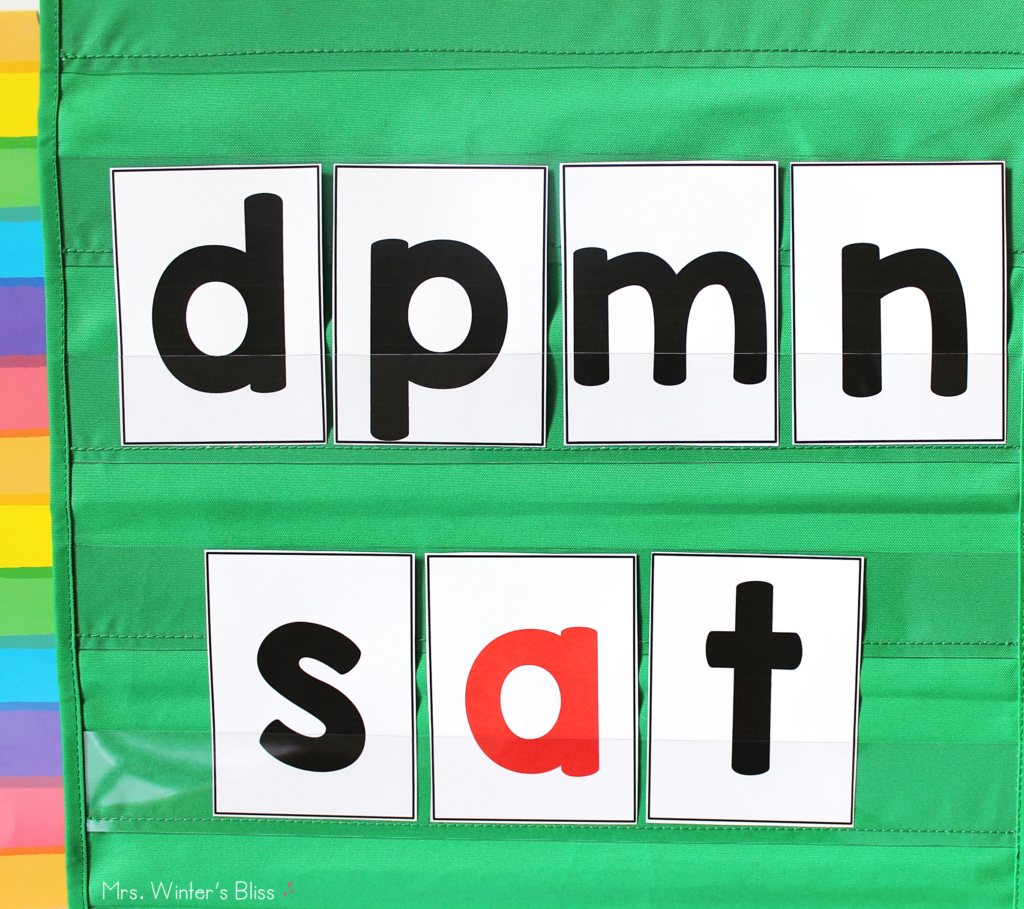
Download a set of these large letter cards for your pocket chart here!
Finally, provide opportunities for guided and independent practice. Continue to change one or more letters in a word and have students chorally blend the new word formed.

Make sure to have a word list prepared before the lesson in order to keep on track with the focus skill and review skills previously taught.

If you are working on word awareness (instead of blending) tell students what the next word is in the sequence and have them form it on their own. After giving them time, form the new word on the pocket chart and model your thinking aloud.
If you have fairly strong word building and word sorts routines in place, an engaging exercise to continue the development of word awareness is Word Ladders.
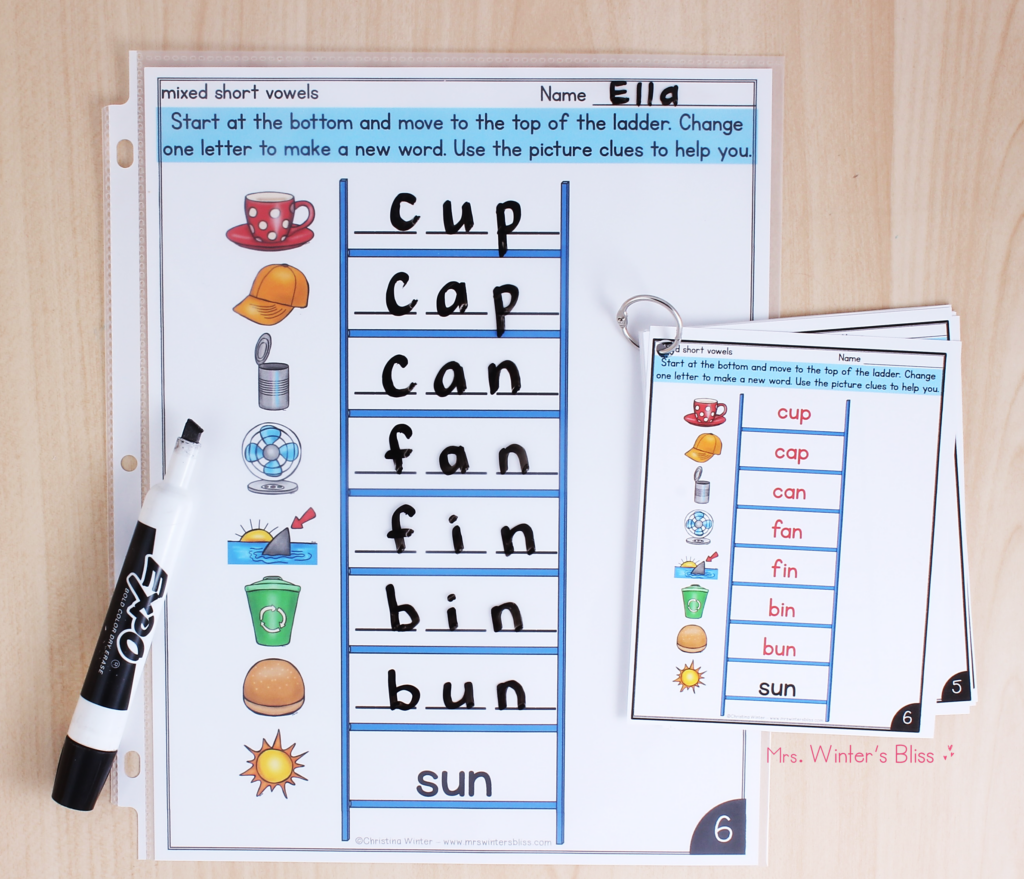
Word ladders are a fun and challenging word activity for students, and a great one to use towards the end of the week once they have had a lot of exposure to the word pattern. Since word ladders are self-checking they are perfect to use in an independent literacy center.
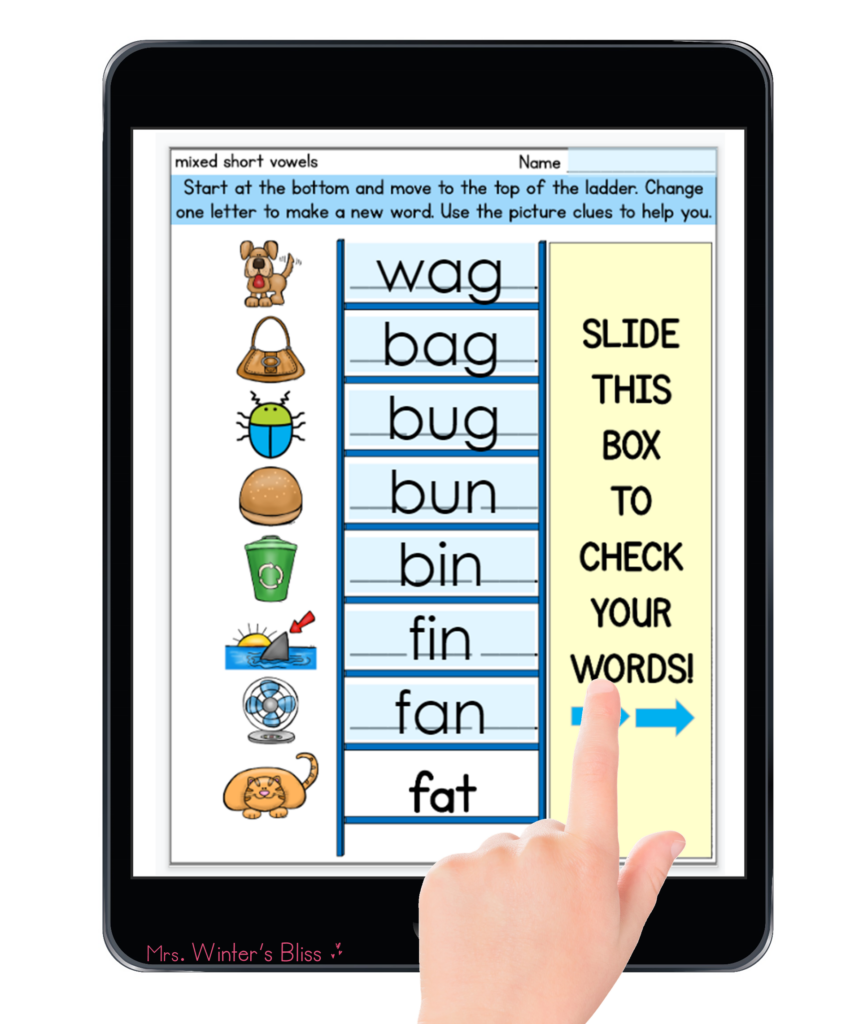
-
Phonics Word Building – Printables + premade Seesaw & Google
Product on sale
$24.50
-
Word Ladders Phonics BUNDLE – digital & printable
Product on sale
$10.00
Rated 5.00 out of 5 based on 2 customer ratings
Phonics Word Building Activities
Today I’m thrilled to share with you my very own Phonics Word Building Activities! These DIFFERENTIATED activities are both printable and digital so you can use them in the classroom or for distance learning with Google Classroom & Seesaw!
Students will listen to the AUDIO directions (from yours truly!) and then build words in a specified sequence. Each new word only varies by one sound spelling from the previous word. Students press the audio button to hear me state the word to build, blend the phonemes of the word, say the word again, and use it in a sentence to develop vocabulary.
This resource includes:
- 31 teacher-directed digital word building lessons
- 31 printable word building lessons
- master word list
Each of the 31 lessons focuses on one phonetic pattern:
- Short Vowel (CVC) Words
- Digraphs
- Blends
- Long Vowels
- Diphthongs
- R-Controlled Vowels
- Complex Vowels
Get started now by downloading your FREE phonics word building activities here:
-
FREE Phonics Word Building – Printables + premade Seesaw & Google
$0.00
Rated 4.75 out of 5 based on 4 customer ratings
Word Ladders
This resource includes both printable and digital word ladders that require students to think critically to figure out the next word to build, using letter or picture clues for support! Students will change just one letter to build a new word.
Included in this resource are 42 word activities- enough to last you the entire year!
Included Phonics Patterns:
- CVC Words
- Digraphs
- Blends
- Long Vowels
- Diphthongs
- R-Controlled Vowels
- Complex Vowels
Both of the Phonics Word Building activities and the Word Ladders provide students explicit and systematic practice. All of the activities in both of the resources are based on Wiley Blevins’ recommended scope and sequence for K-2 students. You can be confident that they are developmentally appropriate and provide the scaffolding students need for mastery.
EASY TO PREP AND MANAGE!
One of the major pitfalls with some word sorts is that they often require a lot of small pieces of paper, letter cuts, or word cards. They can take a long time to prep, distribute, and collect!
But NOT these activities! The printable pieces require very few cuts for students. There will be NO TIME wasted dealing with materials!
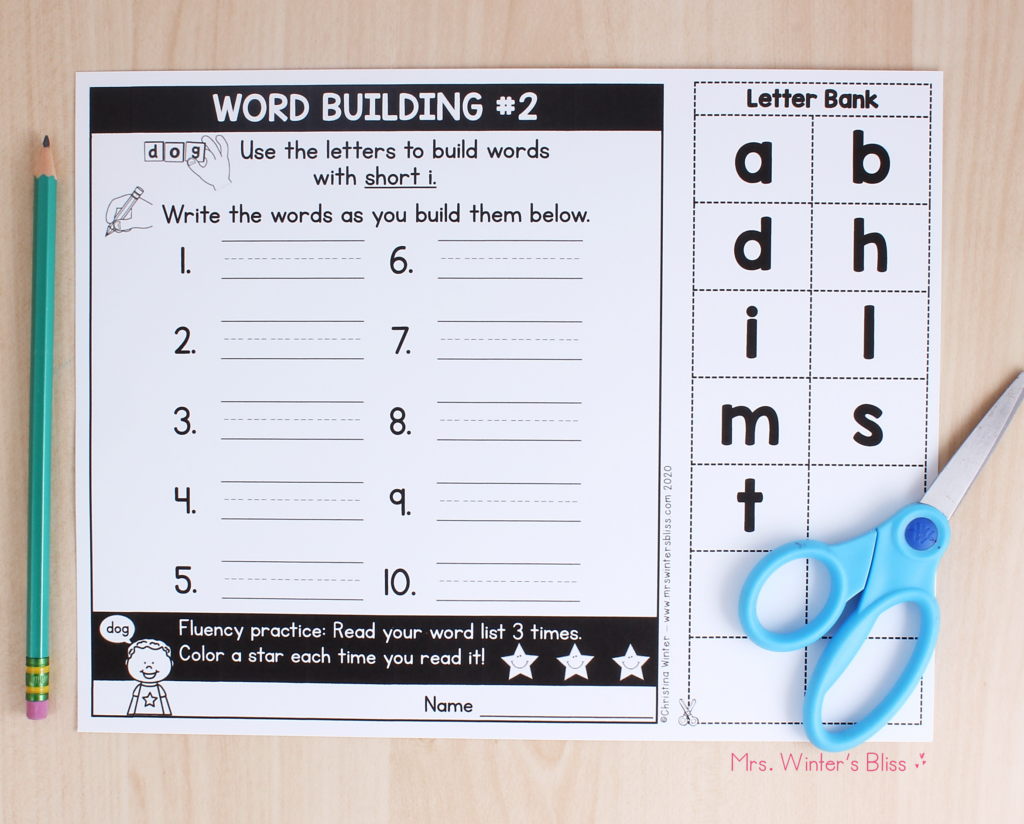
The digital versions have been PRELOADED for you. With 1 click you add them to your Seesaw library or Google Drive and then you can assign them to your students for remote learning or individual centers!

Another BONUS is that the structure of each activity in both of these resources remains the same. This saves you from having to explain and model every time you assign one! Once your students have successfully completed one, you can be sure they’ll be able to independently work through the rest at whatever pace you assign them!
I hope the Phonics Word Building Activities and the Word Ladders I’ve shared today will help you provide your students with meaningful practice that will help them to develop their word awareness and master their phonics skills!
–PIN for LATER–

-SHOP THIS POST-
-
Phonics Word Building – Printables + premade Seesaw & Google
Product on sale
$24.50
-
Word Ladders Phonics BUNDLE – digital & printable
Product on sale
$10.00
Rated 5.00 out of 5 based on 2 customer ratings
WORD-BUILDING is the process of formation, construction or composition of different words.
In English it is always easy to make several new words from a particular root word. You can easily make it’s NOUN, VERB, ADVERB, ADJECTIVE, OPPOSITE, SYNONYM etc. using your language skill. Suffixes and Prefixes can also be easily added to make meaningful words.
For example, let’s take a word free, which is an adjective. We can change the word in different forms,
freedom (Noun)
to free (Verb)
freely (Adverb)
bound (Antonym)
independent (Synonym)
MORE EXAMPLES
Скачать материал

Скачать материал






- Сейчас обучается 396 человек из 63 регионов


Описание презентации по отдельным слайдам:
-
1 слайд
Ways of Word-Building
-
2 слайд
Conversion
I. Definition of conversion: a) different approaches to the phenomenon of conversion; b) conversion and convergence; c) semantic development of the resultant word.
II. Types of conversion. Adjectivization and substantivation.
III. Semantic relations in converted words. -
3 слайд
Definition of conversion
Conversion is a non-affixal way of word-building: e.g. a book — to book
Conversion consists in coining a new word from some existing one by changing the category of part of speech, the morphemic shape of the original word remaining unchanged: e.g. to head an army, to table a resolution, to smooth a dress. -
4 слайд
Definition of conversion
The new word has a meaning, which differs from that of the original one though it can more or less be easily associated with it.
It has also a new paradigm peculiar to its new category as a part of speech: e.g. eye, n: an eye, (the) eyes; eye, v: eyes (3rd person singular), eyed (past indefinite), eying (participle 1). -
5 слайд
Productivity of conversion
The productivity of conversion in the English language is encouraged by
the analytical structure of this language,
the simplicity of paradigms of English parts of speech,
a great number of one-syllable words. -
6 слайд
Convergence and Conversion
On the diachronic level conversion should be distinguished from convergence of sound forms of nouns and verbs, which took place as a result of the loss of endings in the 15-16th centuries:
e.g. OE carian (v), caru (n) > MnE care (v, n);
OE lufian (v), lufu (n) > MnE love (v, n);
OE wyrcan (v), weorc (n) > MnE work. -
7 слайд
Types of conversion
N > V (the most usual direction): a hand – to hand, a wolf – to wolf, a room – to room;
V > N (a frequent direction): to make – a make; to show – a show, to walk – a walk;
Adj > V: pale – to pale, yellow – to yellow, cool – to cool; -
8 слайд
Types of conversion
N > Adj (adjectivization of nouns): “a stone wall”, “a village school”;
Adj > N (substantivation of adjectives): partial (e.g. the blind, the unemployed, the wounded) or complete (e.g. a private, the private(s), the private’s);
Prep / Conj > N: “ins”, “buts”, “ifs”. -
9 слайд
Semantic relations in converted words
-
10 слайд
I. V < N (verbs converted from nouns, i.e. denominal verbs)
verbs have instrumental meaning if they are formed from nouns denoting parts of the human body or from nouns denoting tools, machines, instruments, weapons: e.g. to eye, to finger, to elbow, to shoulder; to hammer, to machine-gun, to rifle, to nail;
verbs can denote an action characteristic of the living being denoted by the noun from which they have been converted: e.g. to crowd, to nurse, to wolf, to ape; -
11 слайд
V < N
verbs can denote acquisition or addition of an object denoted by the noun from which they have been converted: e.g. to fish, to paper;
verbs can denote deprivation or removal of an object denoted by the noun from which they have been converted: e.g. to dust, to peel; -
12 слайд
V < N
verbs can be locative if they are converted from nouns denoting places, buildings, containers: e.g. to park, to garage, to bottle, to corner, to pocket;
verbs can denote an action performed at the time denoted by the noun from which they have been converted: e.g. to winter, to week-end. -
13 слайд
II. V < Adj (verbs converted from adjectives, i.e. deadjectival verbs).
Verbs converted from adjectives denote change of state: e.g. to tame (to become or make tame), to clean, to slim, to calm etc.
-
14 слайд
III. N < V (nouns converted from verbs, i.e. deverbal nouns)
an agent of the action expressed by the verb from which the noun has been converted: e.g. a help, a flirt, a scold;
instance of the action: e.g. a jump, a move; -
15 слайд
N < V
place of the action: e.g. a drive, a stop, a walk;
object or result of the action: e.g. a find, peel.
process or state: e.g. sleep, walk. -
16 слайд
WORD-COMPOSITION
I. Definition of compound words. Specific features of English compounds. Composition and other ways of forming compound words other ways of forming compound words. A compound and a phrase: the criteria of compounds.
II. Diachronic approach to compounds: simplification, demotivation, semi-affixes.
III. Classification of compounds. -
17 слайд
I. Definition
Composition is one of the most productive types of word-building in Modern English, in which compound words are produced.
Compound words are words consisting of at least two stems, which occur in the language as free forms. -
18 слайд
The criteria of compounds
Structural cohesion:
1) the unity of stress (e.g. a `blackboard vs a `black `board),
But: Double stress: e.g. ‘snow-’white, ‘sky-’blue
2) solid or hyphenated spelling (e.g. homework, exercise-book),
But: Different spelling (e.g. blood-vessel / blood vessel ); block compounds (one uniting stress but spelt with a break): e.g. air piracy, cargo module, coin change, etc. -
19 слайд
The criteria of compounds
3) semantic unity (the meaning of the whole compound is not a sum of meanings of its components): e.g. to ghostwrite, skinhead, brain-drain, etc.
But: In non-idiomatic compounds semantic unity is not strong: e.g. airbus, to bloodtransfuse, etc. -
20 слайд
The criteria of compounds
4) the unity of morphologic and syntactic functioning, i.e. they are used in a sentence as one part of it and only one component changes grammatically (e.g. These girls are chatter-boxes.),
5) indivisibility, i.e. the impossibility of inserting another word or word-group between its components. -
21 слайд
Specific features of English compounds
1) Both components in an English compound are free stems, i.e. they can be used as words with a distinctive meaning of their own: e.g. «a green-house» and «a green house».
2) English compounds have a two-stem pattern, with the exception of compound words which have form-word stems in their structure: e.g. middle-of-the-road, off-the-record, up-and-coming, etc. -
22 слайд
Other ways of forming compound words
reduplication (e.g. too-too), reduplication + sound interchange (ablaut): e.g. rope-ripe;
conversion from word-groups: e.g. to mickey-mouse, makeup, etc; -
23 слайд
Other ways of forming compound words
back formation from compound nouns or word-groups: e.g. to bloodtransfuse, to fingerprint, etc.;
analogy: e.g. lie-in, phone-in (on the analogy with “sit-in”), brawn-drain (on the analogy with brain-drain), etc. -
24 слайд
II. Diachronic approach to compounds
-
25 слайд
Simplification of stems
the morphological structure of a compound may undergo certain changes and it turns into a root word: e.g. husband < OE husbonda “master of the house”
-
26 слайд
Demotivation
Due to etymological isolation a compound may lose its ties with formerly correlated words: e.g. breakfast (literally means “to interrupt going without food / прервать пост”), kidnap (literally means “to seize a young goat”). -
27 слайд
Semi-affixes
Some compounds look very much like derivatives due to semi-affixes “man”, “berry”, “land”, “proof”, “like”, “worthy”, “monger”, etc.: e.g. mainland, waterproof, praiseworthy, businesslike, fishmonger. -
28 слайд
III. Classification of compounds
-
29 слайд
I. The means of joining the components:
1) neutral, i.e. words with a mere juxtaposition of components without connecting elements: e.g. headache, film-star, blockbuster;
2) morphological, i.e. words whose components are joined together with a vowel or a consonant as a linking element: e.g. speedometer, handicraft, statesman;
3) syntactical, i.e. words with linking elements represented by form-word stems: e.g. down-and-out, sister-in-law. -
30 слайд
II.The morphologic structure of components
1) compounds consisting of simple stems (compounds proper): e.g. bookcase, blackbird;
2) compounds where at least one of the components is a derived stem (derived, or derivational compounds): e.g. long-legged, chain-smoker; -
31 слайд
II.The morphologic structure of components
3) compounds where at least one of the components is a shortened stem (contracted compounds): e.g. H-bag, math-mistress;
4) compounds where at least one of the components is a compound stem: e.g. wastepaper-basket, aircraft-carrier, singer-songwriter. -
32 слайд
III.The part of speech of a compound
compound nouns (e.g. sunbeam, pickpocket);
compound adjectives (e.g. lifelong, red-hot, hard-working);
compound verbs formed either by means of conversion from compound nouns (e.g. “to weekend” from “a weekend”) or by back-derivation from compound nouns (e.g. “to baby-sit” from “a baby-sitter”); -
33 слайд
III.The part of speech of a compound
compound pronouns (e.g. somebody, nothing);
compound adverbs (e.g. somewhere, inside, headfirst),
compound prepositions (e.g. into, without),
compound conjunctions (e.g. insofar as),
compound numerals (e.g. fifty-five), -
34 слайд
IV. The degree of motivation of compounds
1) non-idiomatic compounds (with a perfectly clear motivation): e.g. “a seaman – a man professionally connected with the sea”;
2) idiomatic compounds (the motivation is vague): e.g. a chatterbox, to blackmail; -
35 слайд
V. The relations between the components
1) subordinative compounds where one of the components is the semantic and structural centre and the second component is subordinate: e.g. custom-house, coast-line
2) coordinative compounds where both components are semantically independent: e.g. secretary-stenographer, woman-doctor, fifty-fifty, no-no, criss-cross, walkie-talkie -
36 слайд
Subordinative relations
purpose or function relations (e.g. bathrobe, classroom, textbook)
local relations (e.g. dockyard, garden-party, sea-front)
comparison (e.g. snow-white)
the material the thing is made of (e.g. silverware, tin-hat) -
37 слайд
Subordinative relations
temporal relations (e.g. summer-house, night-club, day-train)
the first element denoting gender (e.g. she-dog, tom-cat)
the first element pointing out the agent (e.g. cock-crowing)
the first element pointing out the instrument (e.g. pinprick) -
38 слайд
Subordinative relations
limiting relations (e.g. breast-high, knee-deep)
emphatic relations (e.g. dog-cheap)
cause relations (e.g. love-sick)
space relations (e.g. top-heavy), etc. -
39 слайд
VI. The order of the components
direct order (e.g. kill-joy)indirect order (e.g. nuclear-free, rope-ripe)
Найдите материал к любому уроку, указав свой предмет (категорию), класс, учебник и тему:
6 210 058 материалов в базе
- Выберите категорию:
- Выберите учебник и тему
- Выберите класс:
-
Тип материала:
-
Все материалы
-
Статьи
-
Научные работы
-
Видеоуроки
-
Презентации
-
Конспекты
-
Тесты
-
Рабочие программы
-
Другие методич. материалы
-
Найти материалы
Другие материалы
- 26.12.2020
- 276
- 0
- 20.12.2020
- 127
- 0
- 07.12.2020
- 112
- 1
- 08.11.2020
- 113
- 0
- 10.10.2020
- 201
- 1
- 27.09.2020
- 650
- 3
- 26.07.2020
- 109
- 0
- 05.07.2020
- 1890
- 16
Вам будут интересны эти курсы:
-
Курс повышения квалификации «Подростковый возраст — важнейшая фаза становления личности»
-
Курс профессиональной переподготовки «Маркетинг: теория и методика обучения в образовательной организации»
-
Курс повышения квалификации «Специфика преподавания конституционного права с учетом реализации ФГОС»
-
Курс повышения квалификации «Маркетинг в организации как средство привлечения новых клиентов»
-
Курс повышения квалификации «Правовое регулирование рекламной и PR-деятельности»
-
Курс профессиональной переподготовки «Организация менеджмента в туризме»
-
Курс повышения квалификации «Методы и инструменты современного моделирования»
-
Курс профессиональной переподготовки «Организация деятельности специалиста оценщика-эксперта по оценке имущества»
-
Курс профессиональной переподготовки «Методика организации, руководства и координации музейной деятельности»
-
Курс профессиональной переподготовки «Метрология, стандартизация и сертификация»
-
Курс профессиональной переподготовки «Организация деятельности по водоотведению и очистке сточных вод»
-
Курс профессиональной переподготовки «Гостиничный менеджмент: организация управления текущей деятельностью»
-
Курс профессиональной переподготовки «Организация маркетинговой деятельности»
-
Курс повышения квалификации «Информационная этика и право»
Lecture 3. Word-building: affixation, conversion, composition, abbreviation. THE WORD-BUILDING SYSTEM OF ENGLISH 1. Word-derivation 2. Affixation 3. Conversion 4. Word-composition 5. Shortening 6. Blending 7. Acronymy 8. Sound interchange 9. Sound imitation 10. Distinctive stress 11. Back-formation Word-formation is a branch of Lexicology which studies the process of building new words, derivative structures and patterns of existing words. Two principle types of wordformation are distinguished: word-derivation and word-composition. It is evident that wordformation proper can deal only with words which can be analyzed both structurally and semantically. Simple words are closely connected with word-formation because they serve as the foundation of derived and compound words. Therefore, words like writer, displease, sugar free, etc. make the subject matter of study in word-formation, but words like to write, to please, atom, free are irrelevant to it. WORD-FORMATION WORD-DERIVATION AFFIXATION WORD-COMPOSITION CONVERSION 1. Word-derivation. Speaking about word-derivation we deal with the derivational structure of words which basic elementary units are derivational bases, derivational affixes and derivational patterns. A derivational base is the part of the word which establishes connection with the lexical unit that motivates the derivative and determines its individual lexical meaning describing the difference between words in one and the same derivative set. For example, the individual lexical meaning of the words singer, writer, teacher which denote active doers of the action is signaled by the lexical meaning of the derivational bases: sing-, write-, teach-. Structurally derivational bases fall into 3 classes: 1. Bases that coincide with morphological stems of different degrees оf complexity, i.e., with words functioning independently in modern English e.g., dutiful, day-dreamer. Bases are functionally and semantically distinct from morphological stems. Functionally the morphological stem is a part of the word which is the starting point for its forms: heart – hearts; it is the part which presents the entire grammatical paradigm. The stem remains unchanged throughout all word-forms; it keeps them together preserving the identity of the word. A derivational base is the starting point for different words (heart – heartless – hearty) and its derivational potential outlines the type and scope of existing words and new creations. Semantically the stem stands for the whole semantic structure of the word; it represents all its lexical meanings. A base represents, as a rule, only one meaning of the source word. 2. Bases that coincide with word-forms, e.g., unsmiling, unknown. The base is usually represented by verbal forms: the present and the past participles. 3. Bases that coincide with word-groups of different degrees of stability, e.g., blue-eyed, empty-handed. Bases of this class allow a rather limited range of collocability, they are most active with derivational affixes in the class of adjectives and nouns (long-fingered, blue-eyed). Derivational affixes are Immediate Constituents of derived words in all parts of speech. Affixation is generally defined as the formation of words by adding derivational affixes to different types of bases. Affixation is subdivided into suffixation and prefixation. In Modern English suffixation is mostly characteristic of nouns and adjectives coining, while prefixation is mostly typical of verb formation. A derivational pattern is a regular meaningful arrangement, a structure that imposes rigid rules on the order and the nature of the derivational base and affixes that may be brought together to make up a word. Derivational patterns are studied with the help of distributional analysis at different levels. Patterns are usually represented in a generalized way in terms of conventional symbols: small letters v, n, a, d which stand for the bases coinciding with the stems of the respective parts of speech: verbs, etc. Derivational patterns may represent derivative structure at different levels of generalization: - at the level of structural types. The patterns of this type are known as structural formulas, all words may be classified into 4 classes: suffixal derivatives (friendship) n + -sf → N, prefixal derivatives (rewrite), conversions (a cut, to parrot) v → N, compound words (musiclover). - at the level of structural patterns. Structural patterns specify the base classes and individual affixes thus indicating the lexical-grammatical and lexical classes of derivatives within certain structural classes of words. The suffixes refer derivatives to specific parts of speech and lexical subsets. V + -er = N (a semantic set of active agents, denoting both animate and inanimate objects - reader, singer); n + -er = N (agents denoting residents or occupations Londoner, gardener). We distinguish a structural semantic derivationa1 pattern. - at the level of structural-semantic patterns. Derivational patterns may specify semantic features of bases and individual meaning of affixes: N + -y = A (nominal bases denoting living beings are collocated with the suffix meaning "resemblance" - birdy, catty; but nominal bases denoting material, parts of the body attract another meaning "considerable amount" - grassy, leggy). The basic ways of forming new words in word-derivation are affixation and conversion. Affixation is the formation of a new word with the help of affixes (heartless, overdo). Conversion is the formation of a new word by bringing a stem of this word into a different paradigm (a fall from to fall). 2. Affixation Affixation is generally defined as the formation of words by adding derivational affixes to different types of bases. Affixation includes suffixation and prefixation. Distinction between suffixal and prefixal derivates is made according to the last stage of derivation, for example, from the point of view of derivational analysis the word unreasonable – un + (reason- + -able) is qualified as a prefixal derivate, while the word discouragement – (dis- + -courage) + -ment is defined as a suffixal derivative. Suffixation is the formation of words with the help of suffixes. Suffixes usually modify the lexical meaning of the base and transfer words to a different part of speech. Suffixes can be classified into different types in accordance with different principles. According to the lexico-grammatical character suffixes may be: deverbal suffixes, e.d., those added to the verbal base (agreement); denominal (endless); deadjectival (widen, brightness). According to the part of speech formed suffixes fall into several groups: noun-forming suffixes (assistance), adjective-forming suffixes (unbearable), numeral-forming suffixes (fourteen), verb-forming suffixes (facilitate), adverb-forming suffixes (quickly, likewise). Semantically suffixes may be monosemantic, e.g. the suffix –ess has only one meaning “female” – goddess, heiress; polysemantic, e.g. the suffix –hood has two meanings “condition or quality” falsehood and “collection or group” brotherhood. According to their generalizing denotational meaning suffixes may fall into several groups: the agent of the action (baker, assistant); collectivity (peasantry); appurtenance (Victorian, Chinese); diminutiveness (booklet). Prefixation is the formation of words with the help of prefixes. Two types of prefixes can be distinguished: 1) those not correlated with any independent word (un-, post-, dis-); 2) those correlated with functional words (prepositions or preposition-like adverbs: out-, up-, under-). Diachronically distinction is made between prefixes of native and foreign origin. Prefixes can be classified according to different principles. According to the lexico-grammatical character of the base prefixes are usually added to, they may be: deverbal prefixes, e.d., those added to the verbal base (overdo); denominal (unbutton); deadjectival (biannual). According to the part of speech formed prefixes fall into several groups: noun-forming prefixes (ex-husband), adjective-forming prefixes (unfair), verb-forming prefixes (dethrone), adverb-forming prefixes (uphill). Semantically prefixes may be monosemantic, e.g. the prefix –ex has only one meaning “former” – ex-boxer; polysemantic, e.g. the prefix –dis has four meanings “not” disadvantage and “removal of” to disbrunch. According to their generalizing denotational meaning prefixes may fall into several groups: negative prefixes – un, non, dis, a, in (ungrateful, nonpolitical, disloyal, amoral, incorrect); reversative prefixes - un, de, dis (untie, decentralize, disconnect); pejorative prefixes – mis, mal, pseudo (mispronounce, maltreat, pseudo-scientific); prefix of repetition (redo), locative prefixes – super, sub, inter, trans (superstructure, subway, intercontinental, transatlantic). 3. Conversion Conversion is a process which allows us to create additional lexical terms out of those that already exist, e.g., to saw, to spy, to snoop, to flirt. This process is not limited to one syllable words, e.g., to bottle, to butter, nor is the process limited to the creation of verbs from nouns, e.g., to up the prices. Converted words are extremely colloquial: "I'll microwave the chicken", "Let's flee our dog", "We will of course quiche and perrier you". Conversion came into being in the early Middle English period as a result of the leveling and further loss of endings. In Modern English conversion is a highly-productive type of word-building. Conversion is a specifically English type of word formation which is determined by its analytical character, by its scarcity of inflections and abundance of mono-and-de-syllabic words in different parts of speech. Conversion is coining new words in a different part of speech and with a different distribution but without adding any derivative elements, so that the original and the converted words are homonyms. Structural Characteristics of Conversion: Mostly monosyllabic words are converted, e.g., to horn, to box, to eye. In Modern English there is a marked tendency to convert polysyllabic words of a complex morphological structure, e.g., to e-mail, to X-ray. Most converted words are verbs which may be formed from different parts of speech from nouns, adjectives, adverbs, interjections. Nouns from verbs - a try, a go, a find, a loss From adjectives - a daily, a periodical From adverbs - up and down From conjunctions - but me no buts From interjection - to encore Semantic Associations / Relations of Conversion: The noun is the name of a tool or implement, the verb denotes an action performed by the tool, e.g., to nail, to pin, to comb, to brush, to pencil; The noun is the name of an animal, the verb denotes an action or aspect of behavior considered typical of this animal, e.g., to monkey, to rat, to dog, to fox; When the noun is the name of a part of a human body, the verb denotes an action performed by it, e.g., to hand, to nose, to eye; When the noun is the name of a profession or occupation, the verb denotes the activity typical of it, e.g., to cook, to maid, to nurse; When the noun is the name of a place, the verb will denote the process of occupying the place or by putting something into it, e.g., to room, to house, to cage; When the word is the name of a container, the verb will denote the act of putting something within the container, e.g., to can, to pocket, to bottle; When the word is the name of a meal, the verb means the process of taking it, e.g., to lunch, to supper, to dine, to wine; If an adjective is converted into a verb, the verb may have a generalized meaning "to be in a state", e.g., to yellow; When nouns are converted from verbs, they denote an act or a process, or the result, e.g., a try, a go, a find, a catch. 4. Word-composition Compound words are words consisting of at least two stems which occur in the language as free forms. Most compounds in English have the primary stress on the first syllable. For example, income tax has the primary stress on the in of income, not on the tax. Compounds have a rather simple, regular set of properties. First, they are binary in structure. They always consist of two or more constituent lexemes. A compound which has three or more constituents must have them in pairs, e.g., washingmachine manufacturer consists of washingmachine and manufacturer, while washingmachine in turn consists of washing and machine. Compound words also usually have a head constituent. By a head constituent we mean one which determines the syntactic properties of the whole lexeme, e.g., the compound lexeme longboat consists of an adjective, long and a noun, boat. The compound lexeme longboat is a noun, and it is а noun because boat is a noun, that is, boat is the head constituent of longboat. Compound words can belong to all the major syntactic categories: • Nouns: signpost, sunlight, bluebird, redwood, swearword, outhouse; • Verbs: window shop, stargaze, outlive, undertake; • Adjectives: ice-cold, hell-bent, undersized; • Prepositions: into, onto, upon. From the morphological point of view compound words are classified according to the structure of immediate constituents: • Compounds consisting of simple stems - heartache, blackbird; • Compounds where at least one of the constituents is a derived stem -chainsmoker, maid-servant, mill-owner, shop-assistant; • Compounds where one of the constituents is a clipped stem - V-day, A-bomb, Xmas, H-bag; • Compounds where one of the constituents is a compound stem - wastes paper basket, postmaster general. Compounds are the commonest among nouns and adjectives. Compound verbs are few in number, as they are mostly the result of conversion, e.g., to blackmail, to honeymoon, to nickname, to safeguard, to whitewash. The 20th century created some more converted verbs, e.g., to weekend, to streamline,, to spotlight. Such converted compounds are particularly common in colloquial speech of American English. Converted verbs can be also the result of backformation. Among the earliest coinages are to backbite, to browbeat, to illtreat, to housekeep. The 20th century gave more examples to hitch-hike, to proof-read, to mass-produce, to vacuumclean. One more structural characteristic of compound words is classification of compounds according to the type of composition. According to this principle two groups can be singled out: words which are formed by a mere juxtaposition without any connecting elements, e.g., classroom, schoolboy, heartbreak, sunshine; composition with a vowel or a consonant placed between the two stems. e.g., salesman, handicraft. Semantically compounds may be idiomatic and non-idiomatic. Compound words may be motivated morphologically and in this case they are non-idiomatic. Sunshine - the meaning here is a mere meaning of the elements of a compound word (the meaning of each component is retained). When the compound word is not motivated morphologically, it is idiomatic. In idiomatic compounds the meaning of each component is either lost or weakened. Idiomatic compounds have a transferred meaning. Chatterbox - is not a box, it is a person who talks a great deal without saying anything important; the combination is used only figuratively. The same metaphorical character is observed in the compound slowcoach - a person who acts and thinks slowly. The components of compounds may have different semantic relations. From this point of view we can roughly classify compounds into endocentric and exocentric. In endocentric compounds the semantic centre is found within the compound and the first element determines the other as in the words filmstar, bedroom, writing-table. Here the semantic centres are star, room, table. These stems serve as a generic name of the object and the determinants film, bed, writing give some specific, additional information about the objects. In exocentric compound there is no semantic centre. It is placed outside the word and can be found only in the course of lexical transformation, e.g., pickpocket - a person who picks pockets of other people, scarecrow an object made to look like a person that a farmer puts in a field to frighten birds. The Criteria of Compounds As English compounds consist of free forms, it's difficult to distinguish them from phrases, because there are no reliable criteria for that. There exist three approaches to distinguish compounds from corresponding phrases: Formal unity implies the unity of spelling solid spelling, e.g., headmaster; with a hyphen, e.g., head-master; with a break between two components, e.g., head master. Different dictionaries and different authors give different spelling variants. Phonic principal of stress Many compounds in English have only one primary stress. All compound nouns are stressed according to this pattern, e.g., ice-cream, ice cream. The rule doesn't hold with adjectives. Compound adjectives are double-stressed, e.g., easy-going, new-born, sky-blue. Stress cannot help to distinguish compounds from phrases because word stress may depend on phrasal stress or upon the syntactic function of a compound. Semantic unity Semantic unity means that a compound word expresses one separate notion and phrases express more than one notion. Notions in their turn can't be measured. That's why it is hard to say whether one or more notions are expressed. The problem of distinguishing between compound words and phrases is still open to discussion. According to the type of bases that form compounds they can be of : 1. compounds proper – they are formed by joining together bases built on the stems or on the ford-forms with or without linking element, e.g., door-step; 2. derivational compounds – by joining affixes to the bases built on the word-groups or by converting the bases built on the word-groups into the other parts of speech, e.g., longlegged → (long legs) + -ed, a turnkey → (to turn key) + conversion. More examples: do-gooder, week-ender, first-nighter, house-keeping, baby-sitting, blue-eyed blond-haired, four-storied. The suffixes refer to both of the stems combined, but not to the final stem only. Such stems as nighter, gooder, eyed do not exist. Compound Neologisms In the last two decades the role of composition in the word-building system of English has increased. In the 60th and 70th composition was not so productive as affixation. In the 80th composition exceeded affixation and comprised 29.5 % of the total number of neologisms in English vocabulary. Among compound neologisms the two-component units prevail. The main patterns of coining the two-component neologisms are Noun stem + Noun stem = Noun; Adjective stem + Noun stem = Noun. There appeared a tendency to coin compound nouns where: The first component is a proper noun, e.g., Kirlian photograph - biological field of humans. The first component is a geographical place, e.g., Afro-rock. The two components are joined with the help of the linking vowel –o- e.g., bacteriophobia, suggestopedia. The number of derivational compounds increases. The main productive suffix to coin such compound is the suffix -er - e.g., baby-boomer, all nighter. Many compound words are formed according to the pattern Participle 2 + Adv = Adjective, e.g., laid-back, spaced-out, switched-off, tapped-out. The examples of verbs formed with the help of a post-positive -in -work-in, die-in, sleep-in, write-in. Many compounds formed by the word-building pattern Verb + postpositive are numerous in colloquial speech or slang, e.g., bliss out, fall about/horse around, pig-out. ATTENTION: Apart from the principle types there are some minor types of modern wordformation, i.d., shortening, blending, acronymy, sound interchange, sound imitation, distinctive stress, back-formation, and reduplicaton. 5. Shortening Shortening is the formation of a word by cutting off a part of the word. They can be coined in two different ways. The first is to cut off the initial/ middle/ final part: Aphaeresis – initial part of the word is clipped, e.g., history-story, telephone-phone; Syncope – the middle part of the word is clipped, e.g., madam- ma 'am; specs spectacles Apocope – the final part of the word is clipped, e.g., professor-prof, editored, vampirevamp; Both initial and final, e.g., influenza-flu, detective-tec. Polysemantic words are usually clipped in one meaning only, e.g., doc and doctor have the meaning "one who practices medicine", but doctor is also "the highest degree given by a university to a scholar or scientist". Among shortenings there are homonyms, so that one and the same sound and graphical complex may represent different words, e.g., vac - vacation/vacuum, prep — preparation/preparatory school, vet — veterinary surgeon/veteran. 6. Blending Blending is a particular type of shortening which combines the features of both clipping and composition, e.g., motel (motor + hotel), brunch (breakfast + lunch), smog (smoke + fog), telethon (television + marathon), modem , (modulator + demodulator), Spanglish (Spanish + English). There are several structural types of blends: Initial part of the word + final part of the word, e.g., electrocute (electricity + execute); initial part of the word + initial part of the word, e.g., lib-lab (liberal+labour); Initial part of the word + full word, e.g., paratroops (parachute+troops); Full word + final part of the word, e.g., slimnastics (slim+gymnastics). 7. Acronymy Acronyms are words formed from the initial letters of parts of a word or phrase, commonly the names of institutions and organizations. No full stops are placed between the letters. All acronyms are divided into two groups. The first group is composed of the acronyms which are often pronounced as series of letters: EEC (European Economic Community), ID (identity or identification card), UN (United Nations), VCR (videocassette recorder), FBI (Federal Bureau of Investigation), LA (Los Angeles), TV (television), PC (personal computer), GP (General Practitioner), ТВ (tuberculosis). The second group of acronyms is composed by the words which are pronounced according to the rules of reading in English: UNESCO (United Nations Educational, Scientific, and Cultural Organization), AIDS (Acquired Immune Deficiency Syndrome), ASH (Action on Smoking and Health). Some of these pronounceable words are written without capital letters and therefore are no longer recognized as acronyms: laser (light amplification by stimulated emissions of radiation), radar (radio detection and ranging). Some abbreviations have become so common and normal as words that people do not think of them as abbreviations any longer. They are not written in capital letters, e.g., radar (radio detection and ranging), laser (light amplification by stimulated emission of radiation) yuppie, gruppie, sinbads, dinkies. Some abbreviations are only written forms but they are pronounced as full words, e.g., Mr, Mrs, Dr. Some abbreviations are from Latin. They are used as part of the language etc. - et cetera, e.g., (for example) — exampli gratia, that is - id est. Acromymy is widely used in the press, for the names of institutions, organizations, movements, countries. It is common to colloquial speech, too. Some acronyms turned into regular words, e.g., jeep -came from the expression general purpose car. There are a lot of homonyms among acronyms: MP - Member of Parliament/Military Police/Municipal Police PC - Personal Computer/Politically correct 8. Sound-interchange Sound-interchange is the formation of a new word due to an alteration in the phonemic composition of its root. Sound-interchange falls into two groups: 1) vowel-interchange, e.g., food – feed; in some cases vowel-interchange is combined with suffixation, e.g., strong – strength; 2) consonant-interchange e.g., advice – to advise. Consonant-interchange and vowel-interchange may be combined together, e.g., life – to live. This type of word-formation is greatly facilitated in Modern English by the vast number of monosyllabic words. Most words made by reduplication represent informal groups: colloquialisms and slang, hurdy-gurdy, walkie-talkie, riff-raff, chi-chi girl. In reduplication new words are coined by doubling a stem, either without any phonetic changes as in bye-bye or with a variation of the root-vowel or consonant as in ping-pong, chit-chat. 9. Sound imitation or (onomatopoeia) It is the naming of an action or a thing by more or less exact reproduction of the sound associated with it, cf.: cock-a-do-doodle-do – ку-ка-ре-ку. Semantically, according to the source sound, many onomatopoeic words fall into the following definitive groups: 1) words denoting sounds produced by human beings in the process of communication or expressing their feelings, e.g., chatter; 2) words denoting sounds produced by animals, birds, insects, e.g., moo, buzz; 3) words imitating the sounds of water, the noise of metallic things, movements, e.g., splash, whip, swing. 10. Distinctive stress Distinctive stress is the formation of a word by means of the shift of the stress in the source word, e.g., increase – increase. 11. Back-formation Backformation is coining new words by subtracting a real or supposed suffix, as a result of misinterpretation of the structure of the existing word. This type of word-formation is not highly productive in Modern English and it is built on the analogy, e.g., beggar-to beg, cobbler to cobble, blood transfusion — to blood transfuse, babysitter - to baby-sit.
Слайд 1
Word-building
Conversion
Compounding
Afexes
Слайд 2
Conversion
The formation of new words without changing their spelling and
pronunciation.
From the verb
master – to master
house – to house
water – to water
From the adjective
empty – to empty
white – to white
Слайд 3
Compounding
air + field = airfield
birth + place =
birthplace
Слайд 4
Afexes
Prefixes
Suffixes
syllables which we add before certain words to form
new words. The meaning of the new word depends on the prefix that has been used
syllables which we add to the end of the certain words to from new verbs

Слайд 5
Prefixes
The prefixes below are used to express opposite meanings.
de- (destabilise, dethrone)
dis- (disadvantage, disbelief)
in- (insufficient) , il- (before l) illegal
im- (before b,m,p) immature, improbable
ir- (before r) irrelevant BUT unreal, unremarkable
non- (non-dairy),
un- (unattractive, uncivilized)
anti – (anticlockwise)
counter- (counterattack)
Слайд 6
Prefixes
The prefixes with negative meaning
a- (amoral) ab- (absent)
mis-
(misread) non- (nonexistent)
The prefixes with meaning «too»
over- (to overpay) super- (superior)
ultra- (ultra-shot) out- (outlast)
Слайд 7
uni- (one) uniform bi- (two) bilingual
co- (with)
co-educational inter- (between) interstate
inter- (between) interstate multi- (many) multicultural
post- (after) postwar pre- (before) prenuptial
re- (again) redesign semi- (half) semi-circle
sub- under less- (subordinate)
trans- (travel) transatlantic
pro- (in favour of) pro-American
under- (not enough) underdeveloped
ex- (previous, former) ex-president
Prefixes

Слайд 8
Suffixes
Nouns referring to people
verb+ -er/-or/-ar (work – worker, act- actor,
burgle – burglar)
noun/verb/adjective+ -ist (social-socialist)
verb+ -ant/-ent (assist-assistant, reside – resident)
noun+ -an/-ian (republic – republican, Italy – Italian)
verb+ -ee (passive meaning) (employ – employee)
Слайд 9
Nouns formed from verbs
–age post-postage
–al propose-proposal
–ance perform-performance
–ence coincide-coincidence
–ation animate-animation
–ion televise-television
–ment employ-employment
–sion pretend-pretension
–sis hypothesise-hypothesis
–tion describe-description
–ure close-closure
–y discover-discovery
Suffixes
Слайд 10
Nouns formed from adjectives
–ance relevant-relevance
–cy urgent-urgency
–ence patient-patience
–ion isolated-isolation
–iness happy-happiness
–ness sad-sadness
–ity relative-relatively
–ty royal-royalty
–y honest-honesty
Suffixes
Слайд 11
Adjectives formed from nouns
–ous nausea-nauseous
–al nation-national
–ic history-historic
–ical theatre-theatrical
–ish girl-girlish
–ive suppression-suppressive
–ful (with) dread-dreadful
–less (without) name-nameless
–ant brilliance-brilliant
–able reason-reasonable
–y wealth-wealthy
–ly world-worldly
Suffixes
Слайд 12
Adjectives formed from verbs
–able treat-treatable
–ible sense-sensible
–ive exclude-exclusive
–ate consider-considerate
–ent differ-defferernt
Verbs formed from adjectives
–en bright-brighten
–ise real-realise
Verbs formed from nouns
–en strength-strengthen
Suffixes
Слайд 13
literature – Virginia Evans, Jenny Dooley “Wishes”
Marina Bobrova. 1077/2


